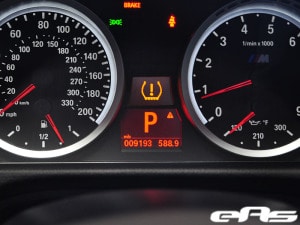Now that the brisk fall mornings are upon us, many of you will start your cars in the morning and be greeted by the worrisome TPMS light.

The pressure in your tires is affected by the ambient temperature outside. Tire pressure will drop approximately 1lb. per ten degrees of outdoor temperature. If your tire pressure was last set during 70 degree temperatures, then you will be approximately 4 lbs. low on that first 30 degree morning; this will trip your TPMS warning light.
When you see your TPMS light, it is VERY IMPORTANT that you check your tire pressure as soon as possible. While tires may be a few pounds low due to the weather, this could also be an indication of a puncture or other severe problem with one, or more than one, of your tires. This is a safety issue, as a compromised tire is prone to a blow-out, making your vehicle extremely hard to control and potentially causing an accident.
Be sure to adjust tire pressure as soon as possible. Remember that driving your car with low tire pressure has three negative impacts on your vehicle.
First. and most important, your vehicle’s handling will be compromised. The small, tire “contact patches” are the areas where your tires meet the pavement, and are responsible for the acceleration, stopping, and turning abilities of your vehicle. Even small changes in tire pressure will have a big impact on those contact patches. Professional racecar drivers adjust each tire by as little as ½ lb. in order to make the car handle precisely the way they want.
Low tire pressure will also negatively impact your fuel economy. Low pressure makes the tires more resistant to rolling; therefore, the engine has to work harder to make the vehicle move. Fuel economy goes down by approximately 0.3% for each 1 lb. drop in tire pressure.
Finally, driving on under-inflated tires has a profoundly negative impact on the life and wear of your tires. Underinflated tires generate more heat and cause excessive wear to the outer edges of the tires.
If you have a good quality tire pressure gauge, you can easily check and adjust your own tire pressure. Here is a tip: Check your tire pressure first thing in the morning, when the air is cold and before you drive anywhere. If your tires are 3 lbs. low, drive to your nearest service station and add 3 lbs. to each. As you continue to drive, tire pressure will increase from the heat generated by friction, as the tires roll on the pavement. It is much better to be 3 lbs. high rather than 3 lbs. low. You can find the manufacturer’s recommended cold-inflation pressures on the driver’s side door jamb.
You can also have your mechanic check and adjust your pressures. Midwest Performance Cars is happy to adjust your pressures and perform a complete vehicle safety check at no charge. Call us at (312) 432-9492 to set up an appointment, or use our online scheduler .











